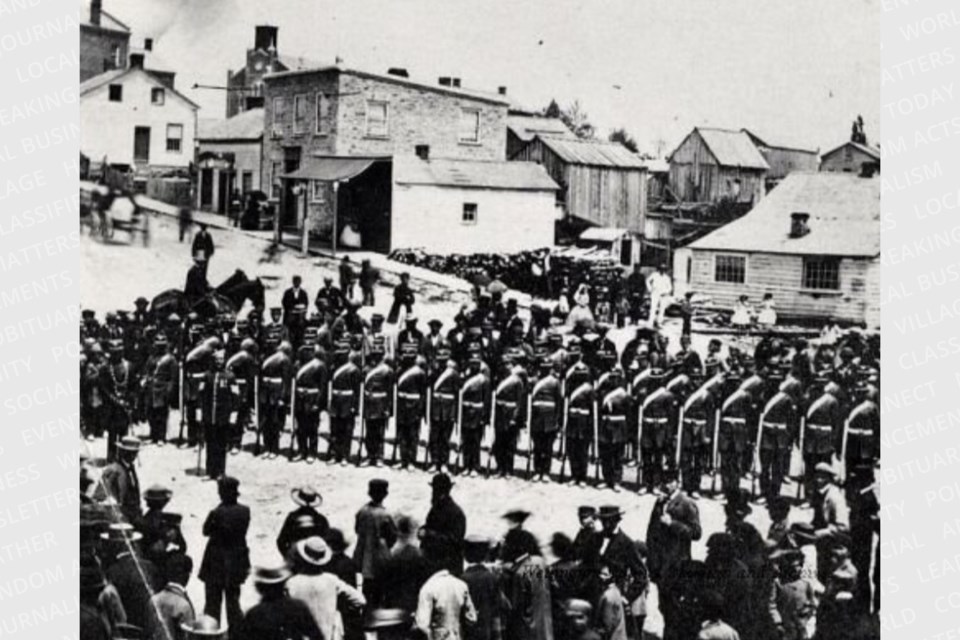Were the members of the first Volunteer Rifle Company of Elora the first military men in Canada to wear khaki?
The light-brownish coloured cloth, whose name comes from an Urdu word meaning “dusty,” was at one time the standard colour of British – and Canadian – army uniforms. In the mid-19th century, khaki tunics gradually began replacing the iconic red coats of British troops in India and Africa, but not in the United Kingdom itself, because Queen Victoria thought the new uniforms were “hideous.”
For many years colonial Canada was garrisoned by British redcoats.
During the War of 1812, Canadian Rangers wearing green uniforms fought alongside the redcoats to turn back the American invaders. When the North West Mounted Police force was established in 1873, the officers and constables were dressed in the familiar scarlet, a colour that was associated with the authority of the British Crown. By the turn of the 20 th century, Canadian soldiers were wearing khaki. According to various accounts, Canadian troops fighting in the South African War (the Boer War) were the first from this country to wear khaki. But not according to Elora historian John Connon (1862 – 1931).
In April of 1861, long-simmering troubles in the United States exploded into civil war. Eleven Southern states formed the Confederacy with the purpose of seceding from the American Union. With the British textile industry heavily dependent on Southern cotton, there was considerable speculation
that Britain would enter the war as an ally of the Confederacy.
That danger accelerated when on Nov. 8, a US Navy warship stopped the British mail ship RMS Trent on the high seas and removed two Confederate diplomats who were on their way to England.
That resulted in much sabre-rattling in London and Washington DC. In anticipation of war, the British government sent troops to bolster the garrisons in its North American colonies. In every community the local militia prepared for the possibility of an American attack. But the militia had grown slack in the peaceful years since the heady days of the War of 1812.
As one chronicler wrote: “Untrained and undisciplined, they showed up in all manner of dress, with belts of basswood bark and sprigs of green balsam in their hats, carrying an assortment of flintlocks, shotguns, rifles and scythes. Their officers, prefacing orders with ‘please,’ recoiled in horror as formations of the backwoodsmen zigzagged on command to wheel to the left.”
Things were somewhat different in Elora. The community was relatively new, and did not have a militia unit.
On July 30, at a public meeting held in the Temperance Hall, it was decided that, “considering the unsettled state of affairs in the neighboring Republic, it is highly desirable that a Volunteer Rifle Company be organized in Elora.”
Within a week the new unit had about 50 volunteers. The number grew after the Trent Affair. The men began drilling in the stone woolen mill even though they had no rifles or uniforms. Fortunately, there was no call to arms. Their biggest event was a Rifleman’s Ball, held on Valentine’s Day, 1862.
Meanwhile, a decision had to be made regarding a uniform. Some members wanted to bring back the green of the Canadian militiamen of an earlier generation that had helped send the American invaders packing. But others thought that since they were paying for their own uniforms, they should
put the matter to a test.
The Company gathered on a common in the northern part of the village. Men were then placed at different distances and covered with samples of cloth of various colours. They found that a fawn-coloured cloth (what we now call khaki) was “the least conspicuous and the most economical.”
It was manufactured at a woollen mill in Galt (now part of Cambridge).
John Connon stated in his book, The Early History of Elora, Ontario, and Vicinity, that “the Elora Company was the first one in Canada to wear the colour that has been found to be the most serviceable, and anticipated by many years the use of what is now called the khaki uniform.”
By the time of the First World War, the expression “wearing the khaki” was synonymous with being in the army.
The Elora Volunteer Rifle Company first paraded outdoors in the new uniform on May 24, 1862. Along with the Volunteer Fire Company, the Hook and Ladder Company and the Elora Brass Band, they marched to Salem and back.
The riflemen met regularly for drills throughout the remaining years of the American Civil War, but there was never any Yankee attack. However, in June of 1866, the Elora Volunteers were called to arms to face the Fenian invasion. As they marched away to board a train in Guelph, each man carried a
rifle and 60 rounds of ammunition.
The Company was sent to Point Edward, near Sarnia, where it was thought the Fenians might attempt a landing, so did not participate in the Battle of Ridgeway. They did see a ship on the St. Clair River flying the Fenian flag, but the Elora men had fishing rods in their hands instead of guns, and were
disappointed that they couldn’t fire a patriotic volley. Which, as it turned out, was just as well. There were no Fenians in the vessel, and the captain had flown the flag on a dare.
When the Fenian scare died down, the Volunteers returned home. Even though they had no battle honours to boast of, the village turned out to meet them and a big picnic was held to welcome back Elora’s – and Canada’s – first men in khaki.



